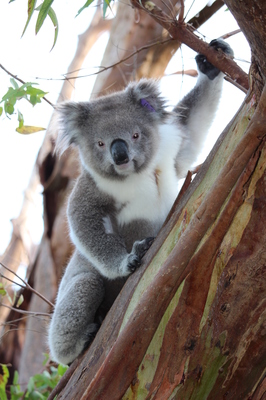Wildlife officers will try again to relieve the pressure on the koala overpopulation at Cape Otway through culls and fertility control, the State Government has announced.
Wildlife officers and vets will carry out a two-week program of fertility control and health checks to manage the koala population in Cape Otway.
The program targets female koalas for capture and fertility control hormone implants to manage breeding rates and address overpopulation this upcoming spring and summer.
The health of all captured koalas will be assessed and koalas fit for release will be returned to their home range.
This follows a relocation of more than 400 koalas to a new home in Great Otway National Park late last year.
Geelong Indy reported overpopulation pressures forced a culling program, but a public outcry prompted the relocation of 374 healthy adult koalas and 74 dependent young.
Authorities hoped the koalas’ new 4300-hectare habitat north of Lorne would address the welfare needs of an “overabundant” population at Cape Otway ahead of summer.
The Lorne site offered several species of eucalypt favoured by koalas, starving after eating out their previous home at Cape Otway.
The latest program will be carried out by the Department of Environment, Land, Water and Planning (DELWP) and involves small teams of trained professionals including experienced koala catchers and veterinarians.
The DELWP said any unhealthy koalas deemed too sick to survive release or with other serious health issues would be humanely euthanased to prevent further suffering.
“Most back young will be independent of their mothers this time of year,” DELWP said.
“However, where female koalas in poor health are euthanased for humane reasons, we will endeavour to re-home orphaned dependent back young with suitably qualified wildlife parks or zoos.”
The DELWP said evidence so far showed the relocation reduced pressure for the remaining koalas and their habitat at Cape Otway over summer.
Field monitoring in February showed the koala density in some parts of Cape Otway was still high, the DELWP said.
“An estimated 600 koalas remain in 120 hectares of Manna Gum and some mixed Eucalypt woodland at Cape Otway.
“Locations with high koala density will be targeted during this program and the focus will be on private properties where koala densities are now reaching up to 11 per hectare.”
The DELWP said it had commissioned the Arthur Rylah Institute (ARI) to conduct a research project on the carrying capacity and habitat health of manna gum dominated areas of the region.
Results from the research would assist koala management at Cape Otway and other forest areas in south-west Victoria.
Get the latest news to your email inbox FREE!
REGISTER






